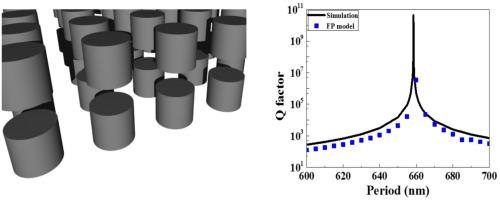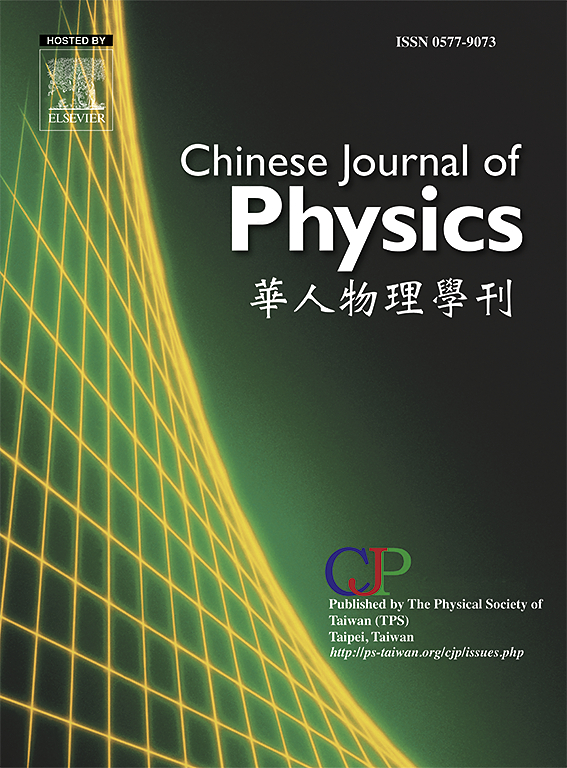基于双介电纳米圆柱元表面的超高品质因数空腔
IF 4.6
2区 物理与天体物理
Q1 PHYSICS, MULTIDISCIPLINARY
引用次数: 0
摘要
具有高品质因数(Q 因子)的光腔对于激光器、单光子源、光学滤波器和传感器等广泛应用至关重要。高 Q 因子空腔可以增强光与材料之间的相互作用,从而提高光学设备的性能。法布里-佩罗(Fabry-Pérot,FP)腔是一种能够实现高 Q 因子的典型光学器件,但它通常依赖于分布式布拉格反射器,从而增加了光学器件的尺寸。近年来,人们开始研究基于米氏散射的高反射率元表面,以替代分布式布拉格反射器。我们提出了一种由两层元表面组成的基于散射的 FP 腔。在我们的结构中,具有高反射率的 FP 腔是通过单个介质圆柱阵列的后向散射形成的。我们的研究结果表明,当周期和间隙尺寸分别为 658.8 nm 和 740 nm 时,该结构的 Q 值系数为 4.36 × 1010。即使两层之间出现错位,也能保持如此高的 Q 因子。此外,我们还证实在低指数基底结构中出现了 2.6 × 106 的高 Q 因子,Q 因子随有限结构中双圆柱的数量而增加。我们还观察到远场在 Z 轴方向具有很强的方向性。我们设计的介质 FP 腔具有亚波长厚度,有望显著提高各类光腔的 Q 因子。本文章由计算机程序翻译,如有差异,请以英文原文为准。

Ultrahigh quality factor cavity based on double dielectric nanocylinder metasurfaces
An optical cavity with a high quality factor (Q-factor) is essential for a wide range of applications, including lasers, single-photon sources, optical filters, and sensors. A high Q-factor cavity can enhance the interaction between light and materials, thereby improving the performance of optical devices. The Fabry–Pérot (FP) cavity is a typical optical device capable of achieving a high Q-factor; however, it often relies on distributed Bragg reflectors, which increase the size of the optical device. In recent years, Mie scattering-based metasurfaces with high reflectivity have been studied as alternatives to distributed Bragg reflectors. We propose a scattering-based FP cavity consisting of two metasurface layers. In our structure, a FP cavity with high reflectivity is formed by back-forward scattering from a single dielectric cylinder array. Our findings show that the structure exhibits a Q-factor of 4.36 × 1010 when the period and gap size are 658.8 nm and 740 nm, respectively. This high Q-factor is maintained even with misalignment between the two layers. Additionally, we confirmed that a high Q-factor of 2.6 × 106 appears in the low-index substrate structure, with the Q-factor increasing with the number of double cylinders in the finite structure. We also observed a strong directionality in the z-axis direction when examining the far field. We designed the dielectric FP cavity with a subwavelength thickness, is expected to significantly contribute to enhancing the Q-factors of various types of optical cavities.
求助全文
通过发布文献求助,成功后即可免费获取论文全文。
去求助
来源期刊

Chinese Journal of Physics
物理-物理:综合
CiteScore
8.50
自引率
10.00%
发文量
361
审稿时长
44 days
期刊介绍:
The Chinese Journal of Physics publishes important advances in various branches in physics, including statistical and biophysical physics, condensed matter physics, atomic/molecular physics, optics, particle physics and nuclear physics.
The editors welcome manuscripts on:
-General Physics: Statistical and Quantum Mechanics, etc.-
Gravitation and Astrophysics-
Elementary Particles and Fields-
Nuclear Physics-
Atomic, Molecular, and Optical Physics-
Quantum Information and Quantum Computation-
Fluid Dynamics, Nonlinear Dynamics, Chaos, and Complex Networks-
Plasma and Beam Physics-
Condensed Matter: Structure, etc.-
Condensed Matter: Electronic Properties, etc.-
Polymer, Soft Matter, Biological, and Interdisciplinary Physics.
CJP publishes regular research papers, feature articles and review papers.
 求助内容:
求助内容: 应助结果提醒方式:
应助结果提醒方式:


